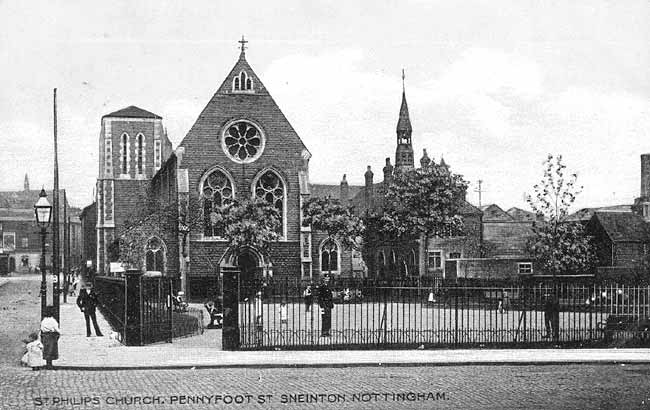< Previous
YESTERYEAR...
By Stephen Best
 THIS EDWARDIAN PICTURE POSTCARD must date from some time after May 30th 1906, when the Pennyfoot Street Recreation Ground, known locally as Cottee Park, was opened.
THIS EDWARDIAN PICTURE POSTCARD must date from some time after May 30th 1906, when the Pennyfoot Street Recreation Ground, known locally as Cottee Park, was opened.The chief feature of the view is the church of St Philip, consecrated in 1879 as a memorial to the Nottingham lace manufacturer and philanthropist Thomas Adams, who had died in 1873. Designed by the local architect R. C. Sutton, the church was built of rock-faced stone, and possessed an impressive eastern apse with seven tall lancet windows. Like a number of Victorian churches in Nottingham, though, St Philip's was never completed; the steeple at the north-east angle, intended to be the dominant feature of the building, remained unhappily curtailed, lower in height than the roof ridge of the nave. When St Philip’s opened, there were 5,000 parishioners, but the demolition of the Carter Gate unhealthy area, where the bus garages now stand, caused a dramatic decline in population. It was only through the devotion and doggedness of the Rev. John Goulton, vicar for over 40 years, that St Philip’s remained open as long as it did. It eventually closed in 1963, and the site of the church and its adjacent schools is now taken up by Boots offices and car park.
Born in Worksop in 1807, Thomas Adams set himself strict personal standards, after an early episode in which he felt he had hurt his relatives and friends. He became a leading Evangelical churchman, and a generous donor of churches and schools in the poorer areas of Nottingham. At his great lace warehouse in Stoney Street, he provided a chapel, where his workers attended service each day, in his time. Adams laid on canteens for his employees, encouraged them to start savings accounts, and tried to ensure that decent medical attention was available to them. Although we may raise an eyebrow at the fact; that he employed children as young as nine, working a 53-hour week, Adams would doubtless have asserted that, had they not been in his employment, they would have been exploited far more harshly by other, less enlightened, masters.
< Previous
